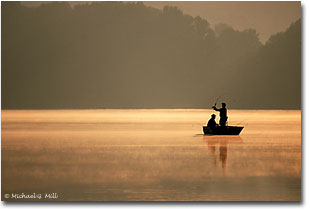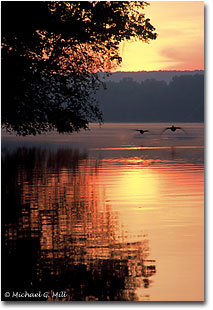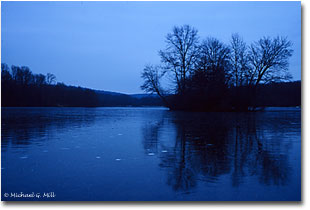|
|

AN ORDINARY PARADISE
Text and photography Copyright Michael Mill
Is my destination a high Alpine meadow in Yellow Stone National Park, a wildlife refuge in Alaska, or perhaps the shoreline of a remote Canadian lake? No, my photographic adventures await at a quite ordinary place by our standards, not unlike millions of others around the globe. My destination of choice is the shoreline of Hopewell Lake in French Creek State Park located in southeastern Pennsylvania. The park is a mere 7,500 acres, for the most part known only by locals, and the lake, not much more than a puddle at 68 acres. Hardly the place to brave chilling winds at four in the morning, just to take pictures..... or is it?
The ever changing color of light, which every serious nature photographer knows can make or break a photograph, is never more evident than when shooting images at a familiar location on a regular basis. To illustrate this point, it may surprise you to learn that the exact location of the tripod for each of the accompanying photographs was less than 30 yards apart, yet the color of light has given each its own unique look and feel. Natural light illuminating any subject is constantly changing, and with this change, comes a change in the appearance of and the emotion derived from any given scene. As nature photographers, we must learn to recognize these changes and use them to our advantage. Shooting images at a familiar location will teach us to use these changes and turn an ordinary scene into a work of art. Of course, the subject matter itself at any given location can change from day to day as well. On my many trips to Hopewell, I've had the opportunity to shoot many varied forms of wildlife, anglers on shore, in boats, and on the ice, sunrises, sunsets, and fall foliage. The list goes on and on. Since I never know what my subject matter might be on any given day, I always take all my equipment with me, especially plenty of film. In this way, I'm prepared for any opportunities that may arise. Nothing is worse than having a beautiful scene unfold before your eyes, and then realizing the perfect lens to shoot it with is sitting on your dresser at home. I must admit, however, that my accumulation of equipment to date is not yet as extensive as that of the average working pro, and I am sure, as my backpack grows heavier and my aging back grows weaker, I may have to reconsider my position on this matter.
Obviously, every trip to your ordinary paradise is not going to produce award winning photographs, but the more time you spend there, the better your chances are of being in paradise at just the right time. It is said that to produce truly outstanding photographs, it is better to be at an average place in the perfect light, than to be at a fantastic place in the wrong light. I've found this to be true, and have been able to capitalize on the perfect light on more than one occasion. When you do the same, you will have truly discovered paradise. When time allows, by all means visit those fantastic spots, but also be sure to discover your own ordinary paradise. Make sure it's convenient, visit it often, learn it well, and appreciate it for what it is. Remember Mother Nature doesn't play favorites. You may be surprised at the results. About the images… Fishermen on a Golden Morning - It was a hazy and foggy morning and it seemed as if the sun was never going to make an appearance. I was just about to make my way into the forest and do some close up photography, when the entire lake lit up in a golden glow. This was one of those times I was glad I had all my equipment with me. I grabbed my 200-400mm zoom, set up my tripod, and carefully composed the scene. I waited for the fisherman to cast his bait and was able to click off a few shots. A dense cloud moved in front of the sun and that beautiful golden glow was gone as quickly as it appeared. Minolta Maxxum 7 Geese Landing at Sunrise - I was shooting the sunrise when I saw these two Canada Geese coming in to my right. I didn't have much time to think, let alone react. I recomposed and shot with the camera settings the way they were. I had my Maxxum set on two second delay to incorporate the mirror lockup so I had to anticipate where they would be when the shutter tripped. Minolta Maxxum 7 Icy Blue Morning - Unlike the other two photographs, this image was planned. The lake had frozen over the week before and I wanted to emphasize the cold with a blue tone. I knew that in the hours before sunrise, the sky would take on a deep rich blue. I took a spot meter reading of the sky and opened up one stop to lighten it. I then doubled that exposure to account for reciprocity failure. Minolta Maxxum 7 Michael Mill - NPN 299 Comments on this article? Send them to the editor. |
|
|
 My sleeping wife barely stirred as I gave her a parting kiss and tiptoed down the stairs. Having donned my quilted coveralls, I filled my thermos with hot coffee, made one last check of my equipment, and looked at my watch, four a.m. Stepping out onto the porch, I'm greeted with the eerie sound of two icy limbs rubbing together in the stiff morning breeze. A Great Horned Owl calls from a distant hillside, to be answered almost immediately by another from the frozen creek off to my left. As my eyes slowly adjust to the pale moonlight, I can just barely make out the forms of two White-tailed Deer moving away from the salt block I had recently placed at the edge of the yard. Breaking out of my momentary trance, I make my way toward my truck. I must not linger here, Mother Nature is preparing to open her most magnificent show and I have to be there when she raises the curtain of darkness for her first act.
My sleeping wife barely stirred as I gave her a parting kiss and tiptoed down the stairs. Having donned my quilted coveralls, I filled my thermos with hot coffee, made one last check of my equipment, and looked at my watch, four a.m. Stepping out onto the porch, I'm greeted with the eerie sound of two icy limbs rubbing together in the stiff morning breeze. A Great Horned Owl calls from a distant hillside, to be answered almost immediately by another from the frozen creek off to my left. As my eyes slowly adjust to the pale moonlight, I can just barely make out the forms of two White-tailed Deer moving away from the salt block I had recently placed at the edge of the yard. Breaking out of my momentary trance, I make my way toward my truck. I must not linger here, Mother Nature is preparing to open her most magnificent show and I have to be there when she raises the curtain of darkness for her first act. I first began photographing at Hopewell out of convenience. Being a part time photographer, I get to practice my craft generally on weekends; therefore my time is limited and Hopewell is only a short drive from my home. However, after shooting at this location over and over again for more than a year, I began to notice that many of the best images in my files had been taken at this seemingly ordinary place. Why? Well first, we must realize that to Mother Nature, there is no such thing as an ordinary place, each is beautiful in its own way. In part, it is our own familiarity that leads us to believe otherwise. Second, we must understand that in nature the scene of the moment will never be repeated in precisely the same way again. There are the obvious changes such as seasons, weather, and the constant movement of wildlife, but we must also recognize the subtle changes of light and shadow as well.
I first began photographing at Hopewell out of convenience. Being a part time photographer, I get to practice my craft generally on weekends; therefore my time is limited and Hopewell is only a short drive from my home. However, after shooting at this location over and over again for more than a year, I began to notice that many of the best images in my files had been taken at this seemingly ordinary place. Why? Well first, we must realize that to Mother Nature, there is no such thing as an ordinary place, each is beautiful in its own way. In part, it is our own familiarity that leads us to believe otherwise. Second, we must understand that in nature the scene of the moment will never be repeated in precisely the same way again. There are the obvious changes such as seasons, weather, and the constant movement of wildlife, but we must also recognize the subtle changes of light and shadow as well. The weather is another element that can change at any time, so be prepared. Unless it is absolutely pouring rain, don't let inclement weather keep you from visiting your own ordinary paradise. Not doing so could mean missing out on some of the best photo opportunities you may ever have. Stormy skies, snow or fog can turn a mediocre photograph into an instant winner. Don't get me wrong, photographing in bad weather can be quite a chore, but the results may well be worth the effort. Protect your equipment and your body. Believe me, I don't think there's anyone on earth that despises cold weather more than I do! However, if you dress properly, and your motor drive is burning through film as a doe and her fawn steps out of the woods for a drink at the waters edge, the adrenaline alone will keep you plenty warm.
The weather is another element that can change at any time, so be prepared. Unless it is absolutely pouring rain, don't let inclement weather keep you from visiting your own ordinary paradise. Not doing so could mean missing out on some of the best photo opportunities you may ever have. Stormy skies, snow or fog can turn a mediocre photograph into an instant winner. Don't get me wrong, photographing in bad weather can be quite a chore, but the results may well be worth the effort. Protect your equipment and your body. Believe me, I don't think there's anyone on earth that despises cold weather more than I do! However, if you dress properly, and your motor drive is burning through film as a doe and her fawn steps out of the woods for a drink at the waters edge, the adrenaline alone will keep you plenty warm.